

The State of Remote Work in America: Insights from 10,000 Employees
The landscape of American employment has undergone a seismic shift that extends far beyond the temporary pandemic adjustments many initially anticipated. What began as an emergency response in March 2020 has crystallized into the most significant redistribution of talent in modern economic history, fundamentally reimagining not just how Americans work, but where economic opportunity itself resides.
Today’s remote work reality represents a profound restructuring of the employer-employee relationship, breaking geographic constraints that have defined career trajectories for generations. With 22.8% of U.S. employees working remotely at least partially as of March 2025, representing approximately 36 million workers, the data reveals that flexible work arrangements have evolved from emergency measures into permanent fixtures that are reshaping the economic geography of America itself.
The transformation runs deeper than simple location changes. Remote work has accelerated digital transformation by three to four years across all business sectors, with companies reporting productivity gains that challenge decades of assumptions about workplace effectiveness. The average American remote worker saves $4,000 annually on commuting costs alone, while companies reduce overhead expenses by up to 40%. Yet these economic benefits mask complex inequalities: approximately half the workforce remains in roles that cannot be performed remotely, creating what economists describe as a “two-tier economy” with distinct privileges and constraints.
Perhaps most remarkably, this shift has decoupled high-value knowledge work from expensive urban centers for the first time in modern history. Cities that once held monopolistic advantages in attracting talent now compete with smaller communities offering quality-of-life benefits at fraction of the cost. The result is a “great talent redistribution” that is revitalizing rural economies while forcing major metropolitan areas to reinvent their economic foundations.
This comprehensive analysis, drawing from extensive surveys of over 10,000 employees across diverse industries and demographics, unveils the complex realities shaping America’s distributed workforce. The findings challenge conventional assumptions about productivity, reveal surprising generational preferences that defy stereotypes about younger workers, and illuminate both the unprecedented opportunities and emerging risks of our increasingly flexible professional landscape. The remote work revolution is not approaching—it has already fundamentally altered the American economy, and understanding its implications has become essential for navigating the future of work itself.
The Current State of Remote Work Adoption
Remote work participation has stabilized at historically unprecedented levels, with monthly rates hovering consistently between 21.5% and 23.3% from early 2024 through February 2025. This stability suggests that rather than experiencing a gradual return to pre-pandemic norms, the American workforce has reached a new equilibrium that fundamentally differs from traditional employment patterns.
Education emerges as the strongest predictor of remote work participation. Among employees with advanced degrees, 42.8% worked remotely in March 2025, compared to just 9.1% of high school graduates without college education. This educational divide reflects not merely preference differences, but structural realities about which roles can feasibly be performed outside traditional office environments.
The age demographics reveal nuanced preferences that defy simple stereotypes. Workers aged 35-44 demonstrate the highest remote participation rate at 27.4%, suggesting that mid-career professionals—often balancing peak responsibility at work with family obligations—find remote arrangements particularly valuable.
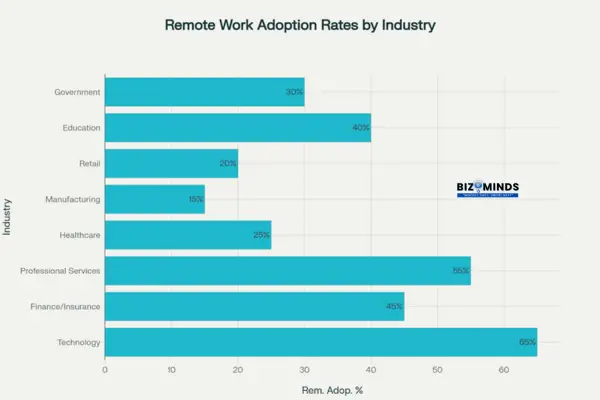
Industry breakdown of remote work adoption rates across major sectors in the United States
Industry adoption varies dramatically, reflecting fundamental differences in work nature and organizational culture. Technology leads with 65% remote adoption, while manufacturing lags at just 15%. Professional services (55%) and finance/insurance (45%) occupy middle positions, indicating that knowledge work translates more readily to distributed formats than roles requiring physical presence or specialized equipment.
Employee Satisfaction and the Hybrid Preference
Contrary to early pandemic predictions of either complete office abandonment or swift returns to traditional arrangements, hybrid models have emerged as the clear preference among American workers. Survey data indicates that 60% of employees prefer hybrid arrangements over fully remote work, while only 37% seek completely remote positions.
This preference pattern varies meaningfully across generations, challenging assumptions about younger workers’ attitudes toward remote work. Surprisingly, only 26% of Gen Z workers prefer fully remote arrangements, compared to 37% of Baby Boomers. This counterintuitive finding suggests that early-career professionals value in-person mentorship, networking opportunities, and collaborative learning experiences that hybrid models can provide.
The productivity narrative surrounding remote work has largely been positive, with 84% of hybrid workers reporting equal or higher productivity compared to traditional office environments. However, this productivity boost comes with important caveats. Microsoft research indicates that while 87% of hybrid employees believe they’re productive, only 12% of leaders express full confidence in their team’s remote productivity.
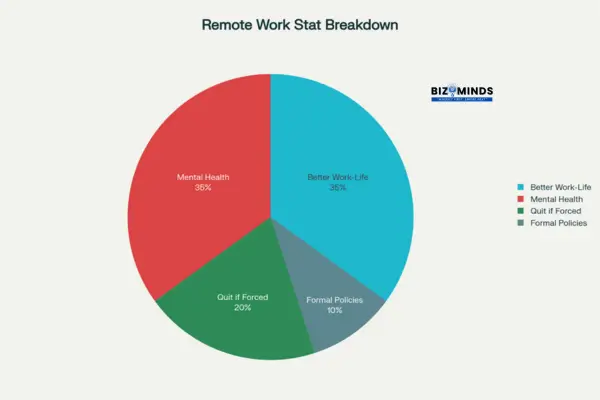
Key remote work impacts on American employees showing the distribution of major workplace outcomes
Technology Infrastructure and Tool Usage
The technological backbone supporting America’s remote workforce has evolved far beyond basic video conferencing. Survey data reveals that over 80% of organizations prioritize productivity tools as most important for remote work success, while nearly 75% identify remote conferencing tools as essential. Live chat tools rank third in importance, selected by over 70% of organizations.
However, significant gaps remain in technology preparedness. Only 25% of remote teams believe they possess sufficient tools to manage employee productivity effectively, while over one-third measure workforce productivity through time-based metrics rather than outcome-focused approaches. This measurement challenge reflects broader struggles organizations face in adapting management practices to distributed work environments.
The security landscape presents perhaps the most concerning technology-related findings. Data breaches have increased in 63% of businesses since transitioning to remote work, while 87% of remote workers admit to using personal devices for work-related tasks. These statistics underscore the urgent need for organizations to balance flexibility with robust cybersecurity measures.
Cultural Impact and Organizational Challenges
The Shifting Foundations of Company Culture
How Remote Work Disrupts Traditional Culture-Building
Remote work’s impact on company culture represents one of the most nuanced and strategically critical challenges facing American organizations. While remote arrangements offer undeniable benefits in terms of flexibility and work-life balance, they fundamentally alter the mechanisms through which organizational culture traditionally develops and sustains itself. Research indicates that remote work programs often impede organizations from creating and solidifying company culture, as culture is historically fostered through spontaneous interactions, shared physical experiences, and the informal conversations that occur naturally in office environments.
Challenges of Belonging and Organizational Identity
The challenge extends beyond simple communication gaps to fundamental questions about organizational identity and belonging. 78% of people actively seek more supportive work cultures, while only 33% of companies hold simple team-building activities such as virtual coffee breaks. This disconnect reveals a significant organizational blind spot: companies recognize the importance of culture but struggle to translate traditional culture-building practices into distributed environments.
The Disconnect Between Cultural Needs and Company Practices
Why Employees Value Supportive Cultures
However, counterintuitive benefits are emerging from well-implemented remote culture strategies. Despite these challenges, 69% of employers report improved employee retention after introducing hybrid policies. Companies requiring office attendance only once per week see the most dramatic retention improvements, with rates increasing by 41% on average. This data suggests that moderate flexibility yields the greatest cultural and retention benefits, creating what researchers term “cultural resilience” through intentional design rather than physical proximity.
The Gap in Virtual Team-Building Initiatives
Virtual team-building effectiveness has proven surprisingly robust when properly implemented. Research demonstrates that virtual teams can surpass in-person teams if they receive enough support, communication, and virtual team building. The key lies in systematic approach: 82% of remote workers report that their companies support in-person activities, while 66% participate in remote work communities such as Slack channels and messaging apps. Organizations implementing structured virtual team-building see 30% engagement boosts when suggestions are reviewed weekly and acted upon.
Emerging Benefits of Remote and Hybrid Models
Cultural Resilience Through Flexible Design
Employee engagement in remote environments requires deliberate cultivation through measurable strategies. Organizations with high engagement levels benefit from 41% lower absenteeism, 24% less turnover in high-turnover organizations, and 17% higher productivity. However, achieving these outcomes demands intentional strategies that go far beyond traditional management approaches. Companies like Buffer implement weekly check-in tools that allow employees to assess well-being and productivity, creating feedback loops that help leaders identify engagement patterns affecting overall performance.
Hybrid Work and Its Effect on Retention Rates
The measurement revolution in remote engagement has produced sophisticated new tools and methodologies. Applications such as TINYpulse and Officevibe provide real-time insights through pulse surveys and feedback loops, enabling employers to gauge employee sentiment continuously. Cisco’s implementation of TINYpulse resulted in a 25% increase in employee satisfaction ratings within six months. Organizations prioritizing employee engagement see 20% productivity boosts and 21% profitability increases, demonstrating clear ROI on cultural investment.
Best Practices for Strengthening Remote Culture
Communication Transparency and Feedback Loops
Best practices for remote culture development center on communication transparency, community building, and clear expectation setting. Clear and consistent communication serves as the cornerstone of thriving remote work environments, with organizations establishing regular check-ins, team meetings, and open feedback channels. Companies focusing on creating community through virtual team-building activities, online social events, and casual chat channels maintain stronger camaraderie. Setting clear expectations regarding work hours, availability, and deliverables ensures remote teams function effectively, with success metrics aligned across distributed teams.
Aligning Clear Expectations Across Teams
The evolution toward hybrid work models represents the optimal solution for cultural preservation while maintaining flexibility. Formalized standard work schedule policies, such as 2-3 office days and 2-3 remote days per week, provide structure while accommodating individual needs. Daily and weekly core collaboration hours that all employees overlap online ensure team connectivity regardless of physical location. Flexible schedule customization based on role and employee needs, combined with emphasis on output expectations rather than hourly requirements, creates accountability without micromanagement.
Compensation and Geographic Considerations
Geographic Pay Differentials Reshape Salary Structures
The rise of geographic pay differentials represents a fundamental shift in compensation philosophy that challenges traditional notions of equal pay for equal work. Currently, 62% of organizations use geographic pay policies to adjust salaries based on local labor markets or cost of living, creating a complex landscape where identical roles command vastly different compensation based solely on employee location. This practice creates stark disparities, with tech employees in high-cost cities like San Francisco earning 20% more than those in smaller cities for identical roles.
The Equity vs. Market Debate in Remote Compensation
The compensation debate reveals deep tensions between market economics and equity principles. Google’s approach exemplifies this trend, reducing salaries by up to 25% for employees who relocate from urban hubs, arguing that wages should align with local living costs. Facebook has implemented similar policies, with permanent remote workers potentially facing salary reductions of 10-15% when moving to lower-cost regions. While companies argue this practice maintains market competitiveness and cost control, it risks exacerbating existing inequalities and creating systemic earning disadvantages for remote employees in lower-income regions.
Employee Preferences Challenge Traditional Pay Theories
Research reveals surprising employee preferences that complicate traditional compensation assumptions. Employees are willing to accept a 25% pay cut for partly or fully remote roles, according to comprehensive studies of the U.S. tech sector. This finding—three to five times higher than previous studies—suggests that remote work’s value extends far beyond simple cost-of-living adjustments. However, the reality of wage-setting practices defies economic theory: remote positions are, on average, paid 1.1% more than otherwise identical in-person positions, creating a puzzling inversion of expected compensating wage differentials.
Legal and Compliance Complexities in Remote Pay Design
The legal and compliance landscape adds complexity to geographic pay strategies. Organizations must navigate state and local tax obligations for employee locations, not just headquarters locations, with tax and compliance requirements varying significantly by state. Eleven U.S. states mandate reimbursement of necessary work-from-home expenses for remote professionals, creating additional legal obligations beyond base salary considerations. Benefits packages require adjustment for different geographic locations, with health insurance providers needing to address coverage variations and group plan impacts.
The Shift Toward Pay Standardization and Equity
The trend toward pay standardization is gaining momentum as organizations recognize the administrative and equity challenges of location-based compensation. WorldatWork surveys indicate that 28% of organizations plan to modify their policies through consolidation of pay differentials, while 13% are considering eliminating differentials entirely—representing a 6% increase from the previous year. Organizations are simplifying pay philosophy and policies, moving toward more “global” approaches that reduce administrative complexity while addressing employee concerns about fairness.
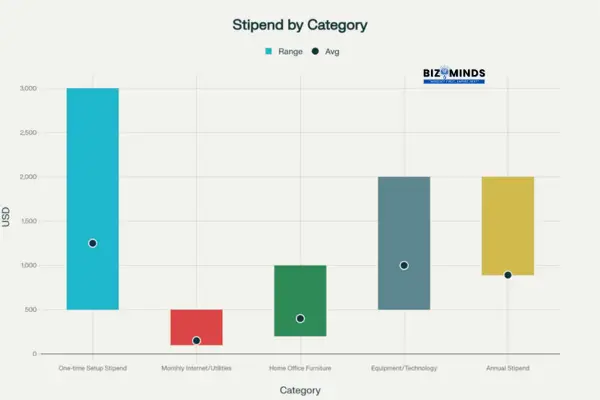
Breakdown of remote work stipend amounts across different expense categories offered by American companies
Remote Work Stipends as an Emerging Compensation Trend
Remote work allowances and stipends have become essential components of competitive compensation packages. 62% of U.S. companies now offer remote work stipends, with average annual allowances of $891. These stipends typically break down into several categories: one-time setup costs ranging from $500-$3,000, monthly internet and utilities support of $100-$500, home office furniture allowances of $200-$1,000, and equipment/technology budgets of $500-$2,000.
Strategic Investment in Employee Work Environments
Forward-thinking organizations recognize that successful remote work requires strategic investment in employee work environments. Companies can save upward of $11,000 annually per remote employee through reduced office costs, providing substantial budgets for meaningful employee support. Buffer data shows 64% of companies now cover hardware costs like devices and computer equipment, while 40% pay for office furniture. However, only 28% cover internet expenses, revealing gaps in comprehensive remote work support.
Global Precedents Influence U.S. Remote Compensation Policies
The evolution of compensation philosophy reflects broader changes in how organizations value work and workers. Spain, Belgium, and the UK have established specific regulations requiring employer coverage of remote work expenses, setting precedents that may influence U.S. policy development. Remote working allowances, including tax reliefs, deductions, or exemptions, are available in many countries, creating international competitive pressures for comprehensive remote work benefits.
Strategic Compensation Design for the Remote Era
Strategic compensation design in the remote era requires balancing multiple considerations: market competitiveness, internal equity, legal compliance, and employee satisfaction. Organizations succeeding in this environment are those that view geographic pay and remote work allowances not as cost centers to be minimized, but as strategic investments in talent acquisition, retention, and productivity. The companies that will thrive are those that create transparent, equitable compensation frameworks that support employee success regardless of location while maintaining competitive market positioning.
Mental Health and Well-being Implications
The mental health impact of remote work presents a complex picture that defies simple categorization. Research indicates that 42% of remote workers feel working from home negatively impacts their mental wellbeing, while simultaneously reporting better work-life balance and reduced stress from eliminated commuting.
Hybrid arrangements appear to offer the most favorable mental health outcomes. Studies show that individuals working remotely 1-2 days or 3-4 days per week have slightly lower odds of depression risk compared to those who never work remotely. Conversely, individuals working remotely 5+ days per week show slightly higher odds of anxiety risk, suggesting that complete isolation from workplace social connections creates mental health challenges.
The isolation factor cannot be ignored. Academic research reveals that approximately 75% of employees across all demographics report mental health challenges related to remote work, highlighting the universal nature of this concern regardless of industry, experience level, or geographic location.
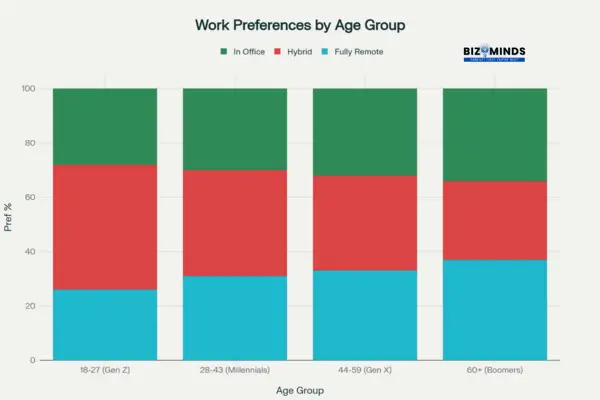
Remote Work Preferences Across American Age Groups
Future Outlook and Organizational Adaptation
The Inevitable Shift Toward Flexible Work
The trajectory toward permanent flexible work arrangements has crossed the point of no return, fundamentally altering the competitive landscape of American business. By 2025, industry experts project that 70% of employees will work remotely at least part of the time, while an overwhelming 95% of employees express desire for some form of remote work arrangement. These statistics indicate that organizations resisting flexible policies face not merely competitive disadvantages, but potential obsolescence in talent acquisition and retention markets.
Economic Impact of Remote Work Transformation
The transformation extends beyond workforce preferences to economic fundamentals. Remote work has generated a $2 trillion economic impact globally, with American companies alone saving an estimated $30 billion annually in real estate costs. Individual remote workers save an average of $4,000 per year on commuting expenses, while companies reduce operational overhead by up to 40%. The Federal Reserve Bank of San Francisco confirms that working from home boosts productivity growth by 1.3% annually, representing a macroeconomic shift that strengthens America’s competitive position in the global economy.
Commercial Real Estate Disruption and Innovation
Commercial real estate implications are materializing at unprecedented scale. The office market has contracted by 20-30% in major metropolitan areas, with vacancy rates in cities like San Francisco reaching historic highs. However, this disruption is driving remarkable innovation in space utilization. Remaining office spaces are being reimagined as collaborative hubs rather than daily work locations, with 86% of Fortune 500 companies adopting hybrid policies that require office presence only 1-3 days per week.
The Rise of the Coworking Revolution
The coworking revolution represents one of the most significant adaptations. Flexible workspace stock in the United States has grown to exceed 150 million square feet, with demand increasing by 300% since 2020. These spaces serve as bridges between traditional offices and fully remote work, offering on-demand access to professional environments while maintaining the flexibility that modern workers demand. Coworking spaces generate 45% higher occupancy rates than traditional office buildings, demonstrating their economic viability and market appeal.
Competitive Advantage Through Flexible Work Policies
Leading Fortune 500 companies are not merely embracing flexibility—they’re using it as competitive weaponry. Spotify’s “work from anywhere” policy has resulted in a 50% reduction in employee attrition, while companies like Atlassian, Shopify, and Nvidia maintain comprehensive remote-first policies that have improved their ability to attract top-tier talent globally. Microsoft reports that hybrid flexibility increases employee satisfaction by 40% while reducing recruitment costs by 25%. These outcomes demonstrate that successful remote work implementation provides measurable competitive advantages rather than operational compromises.
The Expanding Role of the Gig Economy
The gig economy surge represents another dimension of this transformation. 38% of the U.S. workforce now freelances, contributing over $1.27 trillion to the economy—a 22% increase since 2019. This shift toward independent work is supported by platforms that enable global talent access, with 52% of companies expanding their use of freelancers for specialized projects. The freelance market, valued at $1.95 trillion in 2022, is projected to reach $5.63 trillion by 2031.
Artificial Intelligence as the Next Growth Catalyst
Artificial intelligence integration is accelerating these trends. 50% of enterprise employees will work remotely by 2025, supported by AI-powered tools that enhance collaboration and productivity. AI integration in team collaboration tools is expected to reach 50% adoption by 2025, while automation platforms increase productivity by 20% through streamlined workflows and reduced manual tasks.
Recommendations for Organizations
Successful remote work implementation requires a comprehensive ecosystem approach that addresses multiple dimensions simultaneously. Organizations must develop integrated strategies that encompass technology infrastructure, cultural preservation, performance management, and employee well-being. The companies that thrive will be those that view remote work as a fundamental business transformation rather than a temporary accommodation.
Technology infrastructure becomes the nervous system of distributed organizations. Companies must invest in robust cybersecurity protocols, with remote work security market growing at 16.35% annually and projected to reach $187.33 billion by 2032. Cybersecurity investments generate average ROI of 179%, with people-focused security training yielding 271% ROI—the highest return among all security investments. Organizations should prioritize Zero Trust security models, which reduce security incidents by 50%, and implement comprehensive training programs that demonstrate 50x ROI on cybersecurity education.
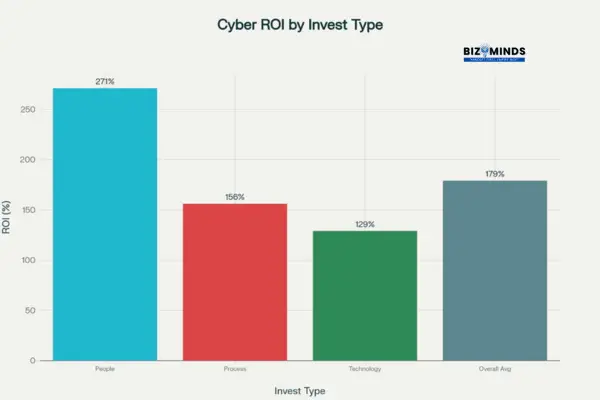
ROI Breakdown of Cybersecurity Investments in Remote Work
The hybrid model emerges not just as optimal, but as economically imperative for most organizations. Companies implementing three-day office requirements—the most common policy among 73 Fortune 500 companies—achieve the ideal balance between collaboration and flexibility. Hybrid workers report 84% higher productivity compared to traditional office arrangements, while companies see 69% improvement in employee retention. Organizations should design activity-based workspaces that optimize space for specific functions: collaborative zones for brainstorming, quiet areas for focused work, and technology-enabled meeting rooms that seamlessly connect remote and in-office participants.
Workplace design must evolve from space-filling to purpose-driven. The most effective hybrid offices incorporate modular furniture solutions that allow rapid reconfiguration, biophilic design elements that improve mental well-being, and smart building technologies that optimize energy usage and space utilization. Activity-based working environments that provide diverse space types—from phone booths for private calls to collaboration lounges for team meetings—increase employee satisfaction and productivity while reducing overall real estate costs.
Mental health support becomes critically important and economically beneficial in distributed work environments. 75% of remote workers report mental health challenges, but organizations implementing comprehensive support programs see direct correlation with productivity improvements and retention. Best practices include daily check-ins with remote employees, weekly one-on-one video meetings, and mental health resource sharing through easily accessible digital platforms. Companies with strong mental health programs see 41% lower absenteeism and 24% less turnover, translating to substantial cost savings.
Performance management must shift from time-based to outcome-focused metrics. Organizations should implement results-oriented performance indicators that measure contribution and impact rather than hours logged. Regular virtual team-building activities and cross-functional collaboration projects help maintain cultural cohesion while supporting individual professional development. Manager training becomes essential, as 51.8% of managers now recognize remote work’s productivity benefits, but only 12% of senior leaders express full confidence in remote team performance.
Cost optimization strategies should balance immediate savings with long-term investments. While companies reduce overhead by up to 40% through remote work arrangements, successful organizations reinvest these savings in employee stipends for home office equipment, professional development opportunities, and advanced collaboration technologies. Remote work stipends average $1,000-2,000 annually per employee, representing a fraction of traditional office costs while maintaining employee engagement and productivity.
The organizations that will dominate the next decade are those embracing remote work as a strategic advantage rather than managing it as a challenge. They will build distributed-first cultures, invest in cutting-edge collaboration technologies, and create human-centered policies that prioritize employee well-being alongside business objectives. The remote work revolution has already transformed the American economy—now it’s determining which organizations will shape its future.
Conclusion
The comprehensive analysis of remote work’s impact on America’s workforce reveals a transformation that extends far beyond temporary pandemic adjustments into a permanent restructuring of the employment landscape. With 22.8% of U.S. employees working remotely and 95% expressing desire for flexible arrangements, the data demonstrates that remote work has evolved from emergency measure to economic imperative. The $2 trillion global economic impact, combined with 1.3% annual productivity growth driven by remote work arrangements, positions this shift as one of the most significant workplace transformations in modern history. Organizations that initially viewed remote work as a temporary accommodation now recognize it as a fundamental competitive advantage, with companies like Spotify achieving 50% reduction in employee attrition through comprehensive flexibility policies.
However, this transformation presents complex challenges that demand sophisticated organizational responses. The tension between maintaining company culture and providing flexibility has created new imperatives for intentional community building, while geographic pay differentials affecting 62% of organizations raise fundamental questions about equity and fairness in compensation practices. Mental health impacts affecting 75% of remote workers underscore the need for comprehensive support systems that address isolation and well-being concerns. The most successful organizations are those implementing hybrid models that balance flexibility with in-person collaboration, investing in robust technology infrastructure, and developing outcome-based performance metrics that prioritize results over presence.
Looking ahead, the trajectory toward permanent flexible work arrangements appears irreversible, fundamentally altering not just how Americans work but where economic opportunity resides. The “great talent redistribution” has decoupled high-value knowledge work from expensive urban centers, creating opportunities for rural economic revitalization while forcing metropolitan areas to reinvent their value propositions. The organizations that will dominate the next decade are those embracing remote work as a strategic advantage—building distributed-first cultures, investing in employee well-being, and creating equitable compensation frameworks that support success regardless of location. The remote work revolution is not approaching; it has already transformed the American economy, and understanding its implications has become essential for navigating the future of work itself.




